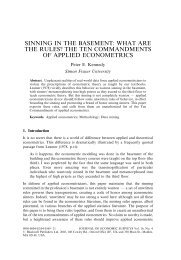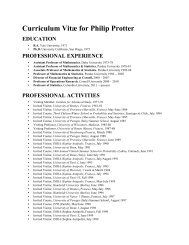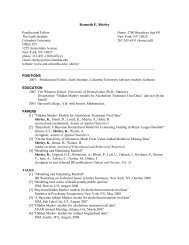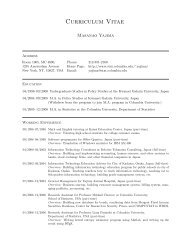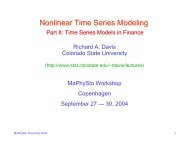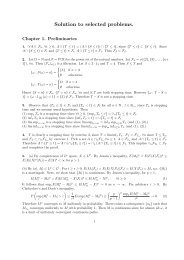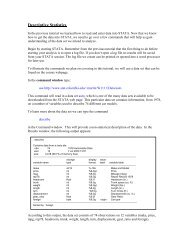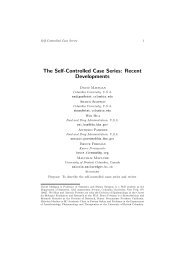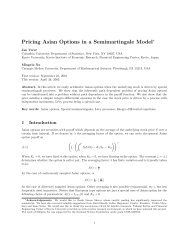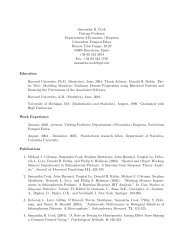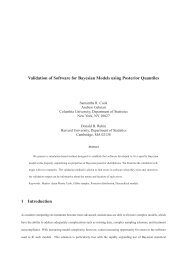W4109: PROBABILITY & STATISTICAL INFERENCE Fall 2008 ...
W4109: PROBABILITY & STATISTICAL INFERENCE Fall 2008 ...
W4109: PROBABILITY & STATISTICAL INFERENCE Fall 2008 ...
You also want an ePaper? Increase the reach of your titles
YUMPU automatically turns print PDFs into web optimized ePapers that Google loves.
<strong>W4109</strong>: <strong>PROBABILITY</strong> & <strong>STATISTICAL</strong> <strong>INFERENCE</strong><br />
<strong>Fall</strong> <strong>2008</strong><br />
Homework 2<br />
1. Consider the Monte Hall game discussed in class. Again, suppose you choose door 1<br />
and the host opens door 2 revealing a goat. At this point the host offers you a choice<br />
between staying with door 1 and switching to door 3. Letting<br />
p = P{host opens door 2 | car is behind door 1}<br />
find the value of p for which you are indifferent between staying with door 1 and<br />
switching to door 3.<br />
2. If you had to construct a mathematical model for events E and F , as described in<br />
parts (a) through (d), would you assume that they were independent events? Explain<br />
your reasoning.<br />
(a) E is the event that a professor owns a car, and F is the event that he is listed in<br />
the telephone book.<br />
(b) E is the event that a man is under 6 feet tall, and F is the event that he weighs<br />
over 200 pounds.<br />
(c) E is the event that a woman lives in the United States, and F is the event that<br />
she lives in the western hemisphere.<br />
(d) E is the event that it will rain tomorrow, and F is the event that it will rain the<br />
day after tomorrow.<br />
3. A and B play a series of games. Each game is independently won by A with probability<br />
p and by B with probability 1 − p. They stop when the total number of wins of one of<br />
the players is two greater than that of the other player. The player with the greater<br />
number of total wins is declared the match winner.<br />
(a) Find the probability that the total of 4 games are played.<br />
(b) Find the probability that A is the match winner.<br />
4. Five men and five women are ranked according to their scores on an examination.<br />
Assume that no two scores are alike and all 10! possible rankings are equally likely.<br />
Let X denote the highest ranking achieved by a woman (for instance, X = 1 if the<br />
top-ranked person is female.) Find P{X = i}, i = 1, 2, . . . , 10.<br />
5. If the cumulative distribution function (cdf) of X is given by<br />
⎧<br />
0 x < 0<br />
1<br />
2<br />
0 ≤ x < 1<br />
⎪⎨ 3<br />
5<br />
1 ≤ x < 2<br />
F (x) =<br />
4<br />
5<br />
2 ≤ x < 3<br />
9<br />
10<br />
3 ≤ x < 3.5<br />
⎪⎩<br />
1 x ≥ 3.5<br />
1
calculate the probability mass function (pmf) of X.<br />
6. Suppose that the cdf of X is given by<br />
⎧<br />
0 b < 0<br />
b<br />
0 ≤ b < 1<br />
⎪⎨<br />
4<br />
1<br />
F (b) =<br />
2 + b − 1 1 ≤ b < 2<br />
4<br />
11<br />
2 ≤ b < 3<br />
12<br />
⎪⎩<br />
1 b ≥ 3<br />
(a) Find P{X = i}, i = 1, 1 2 , 3.<br />
(b) Find P { 1<br />
2 < X < 3 2}<br />
.<br />
7. Two boys play basketball in the following way. They take turns shooting and stop<br />
when the basket is made. Player A goes first and has probability p 1 of making a<br />
basket on any throw. Player B, who shoots second, had probability p 2 of making a<br />
basket. The outcomes of the successive trials are assumed to be independent.<br />
(a) Find the probability mass function for the total number of attempts.<br />
(b) What is the probability that player A wins?<br />
8. Suppose that X has the probability density function (pdf) f(x) = cx 2 for 0 ≤ x ≤ 1<br />
and f(x) = 0 otherwise.<br />
(a) Find c.<br />
(b) Find the cdf of X.<br />
(c) What is P(.1 ≤ X < .5)?<br />
9. The joint pmf of two random variables X and Y is given in the following table<br />
∖ x<br />
1 2 3 4<br />
y<br />
1 .10 .05 .02 .02<br />
2 .05 .20 .05 .02<br />
3 .02 .05 .20 .04<br />
4 .02 .02 .04 .10<br />
(a) Find the marginal pmfs of X and Y .<br />
(b) Are X and Y independent?<br />
(c) Find the conditional pmf of X given Y = 1 and of Y given X = 1.<br />
10. A point is chosen uniformly in the interior of an ellipse:<br />
a 2 + y2<br />
b 2 = 1.<br />
Find the marginal densities of the x and y coordinates of the point.<br />
x 2<br />
2
11. Let X and Y be random variables with the joint cdf<br />
for some fixed α > 0 and β > 0.<br />
(a) Are X and Y independent?<br />
F (x, y) = (1 − e −αx )(1 − e −βy ), x ≥ 0, y ≥ 0<br />
(b) Find the joint and marginal densities of X and Y .<br />
12. Let X and Y be random variables with joint pdf<br />
{<br />
c(x 2 − y 2 )e −x , 0 ≤ x < ∞, −x ≤ y ≤ x<br />
f(x, y) =<br />
0, otherwise.<br />
(a) Find c.<br />
(b) Are X and Y independent?<br />
(c) Find the marginal densities.<br />
(d) Find the conditional densities.<br />
13. Show that if X has density f X and Y = aX + b for some a ≠ 0 then<br />
f Y (y) = 1 ( ) y − b<br />
|a| f X<br />
a<br />
is the pdf of Y .<br />
14. Suppose that F is the cdf of an integer-valued fandom variable, and let U be uniform on<br />
[0, 1] (that is, U ∼ Unif[0, 1].) Define a random variable Y = k if F (k−1) < U ≤ F (k).<br />
Show that Y has cdf F . (This result can be used to generate integer-valued random<br />
variables from a uniform random number generator.)<br />
15. DeGroot & Schervish. A civil engineer is studying a left turn lane that is long<br />
enough to hold 7 cars. Let X be the number of cars in the lane at the end of a<br />
randomly chosen red light. The engineer believes that the probability that X = x is<br />
proportional to (x + 1)(8 − x) for x = 0, . . . , 7 (the possible values of X).<br />
(a) Find the p.m.f of X.<br />
(b) Find the probability that X will be at least 5.<br />
16. DeGroot & Schervish. Suppose that the p.d.f. of a random variable X is as follows:<br />
⎧<br />
⎨ 1<br />
x, for 0 ≤ x ≤ 4,<br />
f(x) = 8<br />
⎩<br />
0, otherwise.<br />
(a) Find the value of t such that P(X ≤ t) = 1/4.<br />
(b) Find the value of t such that P(X ≥ t) = 1/2.<br />
3
17. DeGroot & Schervish. Suppose that X and Y are random variables such that<br />
(X, Y ) must belong to the rectangle 0 ≤ x ≤ 3 and 0 ≤ y ≤ 4. Suppose also that the<br />
joint c.d.f. of X and Y for every (x, y) in the rectagle is as follows:<br />
Determine<br />
F (x, y) = 1<br />
156 xy(x2 + y).<br />
(a) P(1 ≤ X ≤ 2 and 1 ≤ Y ≤ 2);<br />
(b) P(2 ≤ X ≤ 4 and 2 ≤ Y ≤ 4);<br />
(c) the c.d.f. of Y ;<br />
(d) the joint p.d.f. of X and Y ;<br />
(e) P(Y ≤ X).<br />
4



